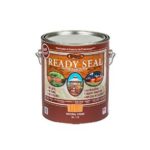Wooden furniture and other surfaces are subject to stains, water damage and stains, and discoloration. Fortunately, you can protect the surface with polyurethane coats, which are impermeable. The polyurethane coat is made of liquid plastic, and you should apply many layers to the wooden surfaces to protect wooden surfaces.
Minwax and Varathane are two companies that produce wood stains and finish to coat the wooden surfaces from the elements. Choosing one polyurethane company over another can be challenging, and this Minwax vs. Varathane guide will help you make the right decision.
What is Minwax?
Minwax is a wood stain with a unique composition and different finish types, making your woodwork stand out. The finish is designed for indoor use and can give your furniture and wooden floors an extended life as it strengthens the structures against weathering.
The finish is oil-based and gives the wooden surfaces a natural look stain, making structures look beautiful. The finish does not give wacky color to the wooden finish as it enhances the wooden grain and prevents water and dust penetration into the wooden surface.
Although you can apply a single Minwax layer to your wood and get the desired results, it is better to apply several coats to get better results.
The stain will resist lapping, and you can cover a large surface with the same product amount. The Minwax is quick to dry, as it can take 2 hours to have a non-tacky surface ready for another coating layer.
However, the drying time will depend on the prevailing conditions. It would be better to let the coat dry effectively before applying another layer to form a consistent stain and wood protective layer.
The Minimax wood stain is economical, and the company claims one quart might cover 137.5 square feet. However, the floor coverage will depend on the number of coats you apply on a surface and whether you use a brush or roller.
When done painting with Minwax stain, it would be better to clean your brushes and rollers in mineral spirit to remove the residual stain, which can damage brushes
What is Varathane?
Varathane is wood protection that works for indoor structures as it does not shield your wooden structures from weather elements. Thus you should avoid using it on wooden structures exposed to rain, wind, and sun.
The wood protection has different colors, and you don’t have to stick with the wood stain, especially if you need to create an indoor theme in the house. The Varathane paint is available in 1 quart and 8-ounce jars; thus, you can choose the appropriate jar depending on the given projects.
The paint manufacturer claims one quart of its paint can cover 150 square feet; however, you should apply several coats to get the desired results. The company instructs users to apply two coats, but it might be better to apply several coats to get the desired results.
The colors are natural shades that suit wooden structures, and they don’t have artificial colors which can meet your needs.
You can stain the wood first before applying Varathane paint to get the desired results. By itself, Varathane does not result in a natural-looking wood stain you would want to achieve, as it merely results in rich color.
The Varathane layer will dry after two hours, as it penetrates the wood grain reducing the drying time. However, the second coat might not penetrate the wood grains, requiring more drying time.
The more Varathane coats you add, the more time you wait for the surface to dry. Finally, when done with Varathane painting, you can clean the brushes and other messes with mineral spirits to reduce damage on the brush.
What is the Difference Between Minwax and Varathane?
Number of Coats
Minwax claims you would need one coat to achieve the desired results; on the other hand, Varathane advises users to apply several coats. Wood surfaces require more coats to appear well done, and you can apply two or more Minwax coats like the Varathane coats.
Applying several coats to the wooden surface costs more, and you will spend more time finishing the wood. However, several coats lead to a thick and beautiful finish, improving the project outcome.
Surfaces
Both paints work well for different surfaces, and you should know the surfaces you will be working on before choosing the product. Minwax is highly practical and is suited for different wood surfaces. You can use the coat on furniture, cabinets, floors, molding, trim, and doors.
The Minwax coats work on unfinished, bare wood, giving it a natural appearance. Thus, it is more versatile than the Varathane, which works only for interior surfaces not exposed to weather elements.
Strength
Although treating wooden surfaces makes them appear beautiful, their coats should increase the surface’s strength. The surface should look beautiful and last for a long time; thus, your coat should protect the wooden surface against dents, humidity, spills, high temperatures, and scratches.
Varathane outperforms Minwax in surface strength, as most of their coats are oil-based, which withstand high temperatures and protect the surface more than the Minwax products, which are mostly water-based.
Penetration
The wood finish penetrates deep into the wood, making it resistant to scratches and peeling. Minwax has more wood penetration as it sinks into the wood grains feeling spaces within the grain to create a natural look.
On the other hand, the Varathane finish only works on the surface and does not penetrate deep into the wooden surface.
Waterproof
A waterproof finish increases the surface’s health and longevity since the wooden structure is exposed to weather elements. Therefore, you should choose a water-resistant finish to prevent your structures from rotting.
Although Varanthane is waterproof, it does not resist the weather elements so well. Thus you would use the finish for indoor surfaces and opt for the Minwax for wooden structures exposed to the weather elements.
Dry Time
Before starting a project, you should consider the dry time, as finishes that take a long time to dry might be frustrating, especially if you are working on a deadline. Varathane has a short drying time, and you should opt for the finish when working on a strict deadline.
However, the number of finish coats and the prevailing conditions might affect the drying time. You can increase the drying period by reducing humidity, increasing air circulation, and controlling the heat in your garage.
Texture
Varathane finish offers a silky smooth finish with a few brush strokes, and if you want a glossy look, you can opt for this finish. On the other hand, the Minwax offers a stained look that is not smooth.
It preserves the natural wood’s look, and you can opt for the finish if you want to give your surface a natural appearance. Minwax improves the wooden texture as it is not glossy and heightens the appearance of the wood grains as it seeps into the wooden surface.
Prices
You should choose a finish paint that fits your price range, especially when operating on a budget. Although Minwax products are cheaper, the company only sells the finish in quartz, and there are no smaller jars that meet consumer needs. Therefore, the finish would be a better option when undergoing extensive projects requiring more finish.
On the other hand, Varathane offers its products in different quantities, and you can easily choose the jars that meet your needs. When buying the paint finishes, remember the coats you need to achieve the desired outcome.
Finish Colors
When you finish painting solely based on the color, you can opt for the natural wood stain or other natural-looking colors. Minwax offers a natural wooden look as it seeps down into the wood grain bringing out its natural color.
On the other hand, Varathane offers different color schemes, but these colors are natural tones. You can choose natural tones for your projects which do not have to heighten the wooden grain color.
Peeling
Varathane does not penetrate the wood grains like Minwax and thus is likely to peel off. Thus you should not use it on wooden surfaces which experience too much friction or those predisposed to weather elements.
However, the finish is more resistant to fading than the Minwax; thus, you can choose one of these wood finishes based on the results you want to achieve.
Minwax vs. Varathane Comparison Table
| Minwax | Varathane | |
|---|---|---|
| Surfaces | Minwax provides a variety of products that can be used to protect any type of wood surface, including unfinished or finished ones. | Varathane is great for the surface of interior finished wood surfaces, like furniture and cabinet. |
| Strength | Minwax is not as durable and provides less protection to the wood than Varathane does. | Varathane provides long-lasting protection against dents, humidity, and scratches as well as high temperature. |
| Penetration | Minwax is designed to penetrate deep into the wood surface, which prevents stains or scratches. | Varathane is not effective at protecting against peeling. |
| Waterproof | Minwax is a great choice for indoor use. It won’t provide a waterproof finish. | Varathane provides a waterproof finish so you can place the wood outside. |
| Dry Time | Minwax dries slower. It depends on how many coats you put on. If you put more, then it will take longer to dry. | If you want a finish to dry quickly, Varathane is the one for you. It will take less time than Minwax products. |
| Texture | Varathane has a better finish than Minwax. | Varathane will make your finish nice and smooth without any brush strokes. |
| Prices | Minwax is cheaper than Varathane, but you need a lot of Minwax for the project. If you have a lot of wood to finish, then the total cost may be similar to Varathane products. | Varathane is more expensive than Minwax. |
Water-Based or Oil-Based Polyurethane: Which is Better?
Although both Varathane and Minwax initially produced oil-based paints only, recently, they started producing water-based paint options. Users are still split between the two paints, but some stick with the original oil-based options.
The water-based options have more color and efficiency, and people can choose one brand over another based on their water-based paints.
All water-based stains don’t fade easily over time, maintain the color much longer, and are less flammable than oil-based paints. Moreover, the water paint is suitable for people with allergies as they don’t have a smell and dries quickly; thus, you will not need to let the wooden surface ‘air out.’
Quick-drying means you might not need to wait an extended time to apply subsequent layers to achieve the final look.
On the other hand, the oil-based finishes are durable, are better to use, and give better-looking colors. Oil-based paints are more popular, and you might find different options in the market.
Thus choosing between oil and water-based paints narrows down to preferences, but it seems the oil-based paint is better as it is durable, has outstanding colors, and is easily available in the market.
Frequently Asked Questions
Can I Use Minwax Over Varathane?
Yes, you can use Minwax over Varathane, especially if you intend to paint wooden surfaces exposed to weather elements. The Minwax finish is water-resistant and does well in outdoor spaces.
What Precautions Do I Need to Take While Dealing With Stains?
Stains can be hazardous, and if they accidentally spill into your hand, you should wash them, and if it gets into your eyes, you should seek medical attention. Thus, you should use gloves and masks when working on the stains.
Moreover, when done with the project, you can clean the brushes with methanol spirits to avoid damage.
What Is The Purpose Of Wood Preparation?
One of the most important steps in any painting project is wood preparation. This crucial step helps ensure that the outcome is clean and professional. Wood preparation involves removing debris or particles that could impact the painting process. This might include dust, dirt, grease, or even old paint.
In addition, wood preparation helps to prepare the wood for Minwax paints. This ensures that the paint will adhere properly and create a smooth, even finish. Finally, wood preparation also helps to make the project appear neater and more polished. By preparing the wood properly, you can avoid common painting mistakes and create a beautiful finished product.
Is Polyurethane Good For Outdoor Use?
Yes, polyurethane is better for outdoor use, especially if the coat is made of an oil-based foundation, making wood structures waterproof. Polyurethane is a plastic coat that prevents outdoor wooden surfaces from rooting and increases longevity.
Are Varathane And Minwax The Same?
Yes, Varathane and Minwax are the same both as wood paint stains, but different companies manufacture them. Both have oil-based and water-based paint finishes which can improve the appearance of the wooden surfaces.
Can You Stain Minwax Poly Over Varathane?
Yes, you can stain Minwax over Varanthane. Minwax gives a natural wooden appearance, and it works best on bare wooden surfaces without any paint layers but works for stained surfaces as well. Thus, sanding the wood before applying the Minwax finish to achieve the desired results would be better.
Conclusion
Minwax and Varathane are finish coats that can improve wooden surface appearance, and different companies manufacture them. Choosing one polyurethane over the other is challenging as they have their limitations and advantages.
For instance, Minwax gives a natural-looking stain and can be applied to different surfaces, while Varathane comes in different natural tones and is suitable for indoor wooden structures. You can choose one of these stains based on the project type, budget, and anticipated outcome.



